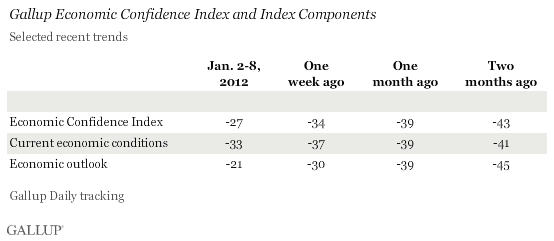PRINCETON, NJ -- The Gallup Economic Confidence Index improved to -27 in the week ending Jan. 8, continuing the steady improvement in the index seen since the summer, when it fell below -50. Americans' economic confidence is now the most positive Gallup has measured since May 2011, and is approaching the -20 level recorded a year ago.

The Economic Confidence Index rose seven points in the past week, up from -34 in the week ending Jan. 1. The index is now up significantly from -39 at the start of December, and from -43 at the start of November.

Americans' perceptions about the economy's direction have improved significantly over this period, rising from -45 two months ago to -21 today -- a 24-point improvement. More specifically, 37% during the week ending Jan. 8 say the economy is getting better and 58% say it is getting worse, producing the -21 outlook rating. By contrast, views about current economic conditions are up eight points, from -41 to -33. Eleven percent of Americans now rate economic conditions "excellent" or "good," while 44% call them "poor."
As a result of these changes, the outlook component of the index is now significantly more positive than the current conditions component, a switch from as recently as early December.
Bottom Line
Gallup's weekly Economic Confidence Index ratings are up significantly from their summer lows, improving by an average of two points each week since early October. If the index continues on that trajectory, economic confidence would cross into positive territory by mid-April, in plenty of time to benefit President Barack Obama's re-election bid.
That scenario likely depends on continued improvement in the nation's unemployment rate. The decline in the government's U.S. unemployment rate -- from 9.2% in late August to 8.5% in December as measured by Gallup -- helped lift Americans' economic mood at the end of 2011, and any setbacks in that area could be equally effective at stifling it. Also, rising gas prices, political conflict in Washington over payroll taxes and the debt ceiling, and continued softness in housing all represent potential drags on consumer optimism. However, at least for now, unemployment and Americans' economic attitudes are both improving, and that has the potential to vastly change the political environment later this year.
Survey Methods
Results are based on telephone interviews conducted as part of Gallup Daily tracking Jan. 2-8, 2012, with a random sample of 3,428 adults, aged 18 and older, living in all 50 U.S. states and the District of Columbia.
For results based on the total sample of national adults, one can say with 95% confidence that the maximum margin of sampling error is ±2 percentage points.
Interviews are conducted with respondents on landline telephones and cellular phones, with interviews conducted in Spanish for respondents who are primarily Spanish-speaking. Each sample includes a minimum quota of 400 cell phone respondents and 600 landline respondents per 1,000 national adults, with additional minimum quotas among landline respondents by region. Landline telephone numbers are chosen at random among listed telephone numbers. Cell phone numbers are selected using random-digit-dial methods. Landline respondents are chosen at random within each household on the basis of which member had the most recent birthday.
Samples are weighted by gender, age, race, Hispanic ethnicity, education, region, adults in the household, and phone status (cell phone only/landline only/both, cell phone mostly, and having an unlisted landline number). Demographic weighting targets are based on the March 2011 Current Population Survey figures for the aged 18 and older non-institutionalized population living in U.S. telephone households. All reported margins of sampling error include the computed design effects for weighting and sample design.
The questions reported here were asked of a random half-sample of respondents for seven nights on the Gallup Daily tracking survey.
In addition to sampling error, question wording and practical difficulties in conducting surveys can introduce error or bias into the findings of public opinion polls.
For more details on Gallup's polling methodology, visit www.gallup.com.
